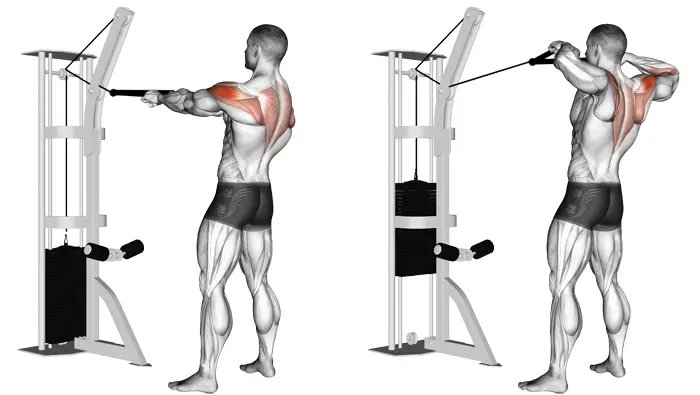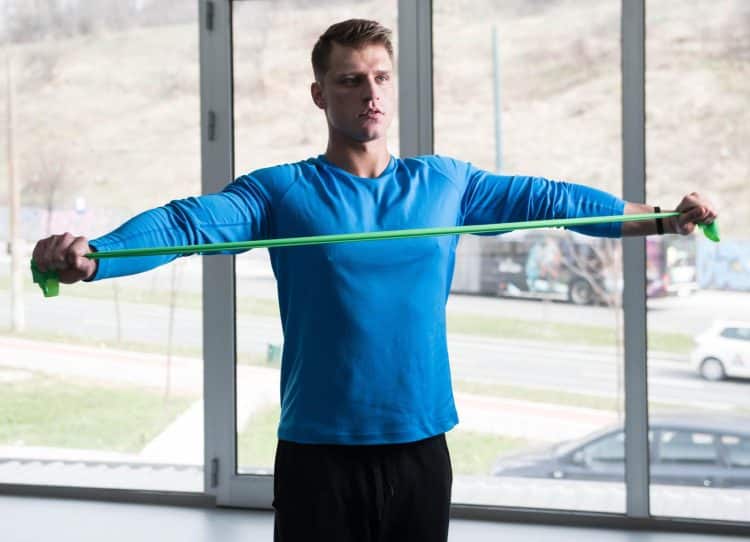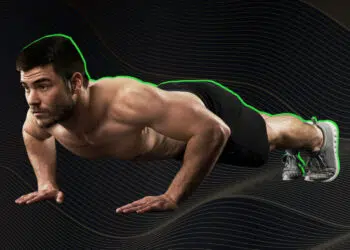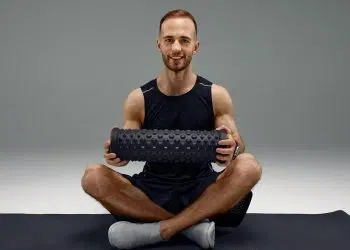Exercise is good for everybody’s body. Working out will help you build the physique or figure of your dreams, improve your fitness, boost your mental health, help you reach and achieve your ideal weight, and enhance almost every aspect of your life.
However, exercise is not without risks. Injuries can happen, and too much exercise can be detrimental to your health and performance.
Thoracic Outlet Syndrome, or TOS for short, is a common condition affecting many exercisers. It typically results in pain and weakness in the arms.
The good news is that it’s usually very preventable and treatable.
In this article, we reveal the best exercises and stretches for Thoracic Outlet Syndrome.
What is Thoracic Outlet Syndrome?
Thoracic Outlet Syndrome (TOS) is a medical condition where the nerves or blood vessels of the thoracic outlet become compressed. The thoracic outlet is the space between your clavicle (collarbone) and the first rib.
Level Up Your Fitness: Join our 💪 strong community in Fitness Volt Newsletter. Get daily inspiration, expert-backed workouts, nutrition tips, the latest in strength sports, and the support you need to reach your goals. Subscribe for free!
Nerves and blood vessels affected by TOS include the brachial plexus, and subclavian arteries and veins, all of which supply the arms.
TOS symptoms include:
- Arm pain
- Weakness
- Numbness/tingling
- Discoloration
- Swelling
- Muscle atrophy
- Bulging veins
- Numb or cold hands
Occasionally, TOS can result in an aneurysm or embolism, but severe complications are rare and only account for 1-2% of cases (1).
There are three main types of TOS, and symptoms may vary between each one. The types of Thoracic Outlet Syndrome are:
1. Neurogenic Thoracic Outlet Syndrome:
This is the most prevalent form of TOS and accounts for most cases (2). In this type of Thoracic Outlet Syndrome, the brachial nerves are compressed, leading to weakness and dysfunction in the arms and hands.
2. Venous Thoracic Outlet Syndrome
Venous TOS occurs when one or more veins (i.e., subclavian vein, axillary vein) are compressed. This reduces blood flow into the arms. Venous TOS accounts for around 3%–5% of all Thoracic Outlet Syndrome cases (2).
3. Arterial Thoracic Outlet Syndrome
This is the least common but most dangerous form of TOS. In arterial TOS, the arteries (i.e., subclavian artery, axillary artery) under the collarbone are compressed. This could potentially result in an aneurism, although only 1%–2% of cases of Thoracic Outlet Syndrome is arterial.
What are the Causes of Thoracic Outlet Syndrome?
Neurogenic Thoracic Outlet Syndrome… over diagnosed or under recognised? https://t.co/OpMUgi34Yb pic.twitter.com/TcvXpauHZe
— The Sp⚽️rts Physio (@AdamMeakins) April 9, 2018
Thoracic Outlet Syndrome can be caused by many different things. For example, you may have been born with a narrow thoracic outlet and are more prone to TOS as a result.
In addition to genetics, TOS can be caused by poor posture, neck injuries, violent impacts such as car accidents, repetitive shoulder, and neck movements, and even improper exercise technique.
While most incidences of TOS can be treated with physical therapy, including stretching and strengthening exercises, surgery may be necessary to fix more severe cases.
Because of this, if you experience any of the symptoms of Thoracic Outlet Syndrome, you should get it checked medically for a precise diagnosis. However, in most cases, the treatment will revolve around the exercises outlined in the following section.
9 Thoracic Outlet Syndrome Exercises & Stretches
So, you’ve been diagnosed with Thoracic Outlet Syndrome? Don’t panic!
Providing your doctor says it’s okay to do so, these are the exercises that will help alleviate your condition. These movements help open up your thoracic outlet, taking pressure off the nerves and blood vessels.
1. Resistance band pull-apart
Target muscles: Middle trapezius, rhomboids, posterior deltoids.
Poor posture is a leading cause of Thoracic Outlet Syndrome. As your shoulders and upper back roll forward, the thoracic outlet is compressed, leading to pressure on the enclosed nerves and blood vessels. This straightforward exercise strengthens the muscles responsible for pulling your shoulders back into good posture.
How to do it:
- Hold a resistance band out in front of you at shoulder height. Your palms should face downward, and your hands should be about shoulder-width apart.
- Bend your knees slightly for balance, and brace your abs. Pull your shoulders down and back. Tuck your chin in and stand up tall.
- Keeping your arms slightly bent but rigid, open your arms and stretch the band out across your chest.
- Pause with your arms out for 1-2 seconds before returning to the starting position.
Tips:
- Do 3-5 sets of 15-20 reps every day.
- Do sets of band pull-aparts between sets of chest training.
- Keep a band in your desk drawer and use it to break up long periods of sitting.
Read also: The band pull-apart for better posture and performance
2. Chin-tucks
Target muscles: Deep neck flexors
If you spend any time sitting in front of a computer screen or driving, you probably crane your head forward. This can cause a postural abnormality called chin-jut or, more unkindly, nerd neck. Nerd neck can compress your thoracic outlet, leading to TOS. Chin-tucks stretch the muscles responsible for pulling your head forward while strengthening those that hold your head up.
How to do it:
- Sit or stand in good posture with your shoulders down and relaxed.
- Next, pull your chin in and lengthen your neck. Imagine you are lifting the crown of your head toward the ceiling.
- You should see a “double chin” in the mirror as the skin of your neck folds and creases.
- Hold for a few seconds, relax, and repeat.
Tips:
- Do this exercise leaning against a wall or lying on the floor to put your neck into good posture.
- Precede this exercise with some anterior neck stretches to increase your range of motion.
- Do this exercise every hour or so to break up long periods of sitting or working at a computer.
3. Face pulls
Target muscles: Middle trapezius, rhomboids, posterior deltoids, biceps.
Face pulls work many of the same muscles as band pull-aparts. However, because you’re using a cable machine in the gym, it’s easier to select the ideal resistance for your workout. Also, cable exercises tend to keep your muscles under constant tension, making them a little more effective. Do this exercise whenever you’re in the gym.

How to do it:
- Attach a rope handle to an adjustable pulley machine. Raise the pulley to around chest height.
- Hold a handle in each hand and step back, so your arms are straight and extended in front of you. Adopt a staggered stance for balance. Pull your shoulders down and back, and brace your abs. Tuck your chin in and stand up tall.
- Keeping your elbows up, bend your arms and pull your hands into either side of your head. Imagine you are trying to poke your thumbs into your ears.
- Extend your arms and repeat.
Tips:
- You can also do this exercise seated.
- No cable machine? You can also do face pulls with a resistance band attached to a chest-high anchor.
- Focus on leading with your elbows – imagine you are trying to elbow the nose of someone standing behind you!
- Keep your wrists straight, and your arms parallel to the floor throughout.
4. Seated wide grip row to chest
Target muscles: Middle trapezius, rhomboids, posterior deltoids, biceps.
Level Up Your Fitness: Join our 💪 strong community in Fitness Volt Newsletter. Get daily inspiration, expert-backed workouts, nutrition tips, the latest in strength sports, and the support you need to reach your goals. Subscribe for free!
All rowing exercises work the muscles between your shoulders, i.e., the middle trapezius and rhomboids. However, in most cases, it’s the lats that are doing most of the work. One simple modification can turn any rowing exercise into an excellent mid-back exercise that can help alleviate and prevent Thoracic Outlet Syndrome.
How to do it:
- Attach a long lat pulldown bar to a seated row machine. Sit on the bench and hold the bar with an overhand, wider-than-shoulder-width grip.
- Sit up tall with your legs extended in front of you, knees slightly bent. Brace your core and pull your shoulders down and back.
- Keeping your wrists straight and leading with your elbows, bend your arms and row the bar into your lower chest/sternum. Pause for 1-2 seconds.
- Slowly extend your arms and repeat.
Tips:
- This exercise works best when done for medium to high reps with a light to moderate weight.
- No seated row machine? You can also do wide-grip bent-over barbell rows and wide-grip incline rows.
5. Prone snow angel
Target muscles: Middle trapezius, rhomboids, posterior deltoids.
No gym? No problem! You can train your upper back and open up your thoracic outlet space with a simple bodyweight exercise. Do this movement at home, at work, on vacation, or any other time you want to strengthen your upper back while you mobilize your shoulders and chest.
How to do it:
- Lie on the floor with your forehead resting on the ground, and extend your arms flat on the floor in front of you.
- Without arching your lower back, retract your shoulders, lift your hands off the floor, and sweep your arms out and around until they are by your sides.
- Sweep your arms forward again, rest them on the floor, and then lift and repeat.
Tips:
- Lie on a mat for comfort and hygiene.
- You can also do this exercise with your back against a wall, i.e., standing wall angels.
- Keep your palms turned down toward the floor throughout.
6. Scalene stretch
Target muscles: Scalenes and deep neck flexors.
The scalenes are the muscles on the side of your neck. If they become tight, these muscles can reduce your thoracic outlet space on that side. If you spend a lot of time on the phone with your head tilted to one side, you probably have tight scalenes.
How to do it:
- Sit in a chair or on a bench with your feet flat on the floor, and your knees bent to 90 degrees. Adopt a good posture with your torso upright and shoulders relaxed.
- Gently lean your head to the side, trying to touch your shoulder with your ear.
- Hold for 20-30 seconds.
- Slowly lift your head and then switch sides.
Tips:
- Get a deeper stretch by resting your hand on your head and gently pulling it over and down.
- Do this exercise hourly to break up long periods of sitting.
- Turn your head to find additional areas of neck tightness.
7. Doorway chest stretch
Target muscles: Pectorals major, anterior deltoids.
Tight pecs are a common problem for many lifters. Endless sets of bench presses and push-ups will make your chest big and strong but invariably leads to muscle tightness, too. Tight pecs are a leading cause of Thoracic Outlet Syndrome. Stretch your pecs often to treat and prevent TOS.
How to do it:
- Stand in an open doorway.
- Place your forearms on the vertical doorframe, so your elbows are level with your shoulders.
- Using a staggered stance for balance, gently push your chest forward and between your arms.
- Hold for 20-60 seconds.
Tips:
- Do this exercise several times a day to improve chest flexibility.
- Break up long periods of sitting by doing this stretch.
- Raise or lower your arms slightly to target different groups of chest fibers.
- You can also do this exercise in the corner of a room.
8. Quadruped thread the needle
Target muscles: Trapezius, rhomboids, deltoids, erector spinae.
This exercise mobilizes your thoracic spine while stretching many of your upper body muscles. Rotational movements are becoming increasingly rare in modern life. This exercise will help break you out of the so-called sagittal plane.
How to do it:
- Kneel on all fours with your palms flat and your spine neutral. Make sure your knees are directly below your hips and your hands are directly below your shoulders.
- Lift your left hand, then gently thread it beneath your right arm, allowing your left shoulder to touch the ground.
- Next, bring your left arm back and then reach up toward the ceiling, allowing your chest to rotate outward.
- Bring your arm back down and repeat.
- Perform 8–12 reps and then swap sides.
Tips:
- Move slowly and deliberately to maximize the effect of this exercise.
- Kneel on a mat for comfort.
- Increase your range of motion rep by rep as your muscles and joints warm up.
9. Foam rolling of the thoracic spine
Target muscles: Middle trapezius, rhomboids.
Massage can help treat Thoracic Outlet Syndrome. However, getting a massage is not always possible or convenient, and it can be expensive, too. The good news is you can enjoy many of the benefits of massage for a very low price and anywhere you can find a space to lie down. All you need is a cheap foam roller.
How to do it:
- Lie on your back on the floor with your legs bent and your foam roller beneath your shoulders.
- Lift your hips and push with your legs, so the roller moves down your back. Rest across the roller and let the weight up your head and upper body extend your thoracic spine.
- Continue all the way down your upper back and then back up, paying extra attention to any areas that feel tight.
- Note: It’s quite normal to experience a few thoracic spine clicks the first few times you do this exercise.
Tips:
- This exercise can be uncomfortable initially but will get easier after a few attempts.
- Keep the roller away from your neck and lumbar spine or lower back, as they’re already naturally extended.
- Use a solid foam roller, if available, rather than a plastic tube covered in textured padded foam. The softness of a solid foam roller will make this exercise much more enjoyable.
Exercises and Activities to Avoid with Thoracic Outlet Syndrome
Exercise is generally good for Thoracic Outlet Syndrome, and inactivity often makes it worse. That said, there are a few exercises and activities that could make your symptoms more severe. Avoid anything that causes pain, as well as the following:
A lot of chest exercises
Common chest exercises like bench presses, push-ups, and dips may make TSO more painful, so reduce the volume and intensity of your pec workouts. Wide grip exercises tend to be the worse, so consider using a shoulder-width grip. You may also find dumbbell exercises more forgiving than barbells, and using a slight incline can also be helpful.
Overhead movements
Some people find overhead barbell, and dumbbell presses make their TOS symptoms worse. If shoulder presses cause you problems, switch to exercises like dumbbell and cable front and lateral raises. That way, you can continue to train your shoulders without raising your arms above your head.
If you decide to do overhead presses, use a bench set to a high incline, say 70-80%, which may be more forgiving.
Barbell back squats
Despite being a leg exercise, barbell back squats place your shoulders in a very stressful position that could exacerbate your TOS symptoms. You don’t need to give up squats entirely (heaven forbid!). Still, you will probably find front squats, goblet squats, and safety bar squats much more comfortable.
Slouching over your desk, screen, or steering wheel
Slouching reduces the size of the thoracic outlet. While you won’t be able to fix your posture overnight, your symptoms will be less severe if you do your best to sit and stand upright and minimize slouching.
Set a timer to sound every 30 minutes or so, and use it to remind you to sit or stand up straight. Also, ensure your workstation is set up as ergonomically as possible and that your chair, keyboard, and screen are at the optimal height.
Don’t hold your phone between your ear and shoulder
This common practice can cause your scalenes and other neck muscles to tighten up. Rather than hold your phone between your ear and shoulder to free up your hands, use earbuds or a headset to save your overworked neck.
You won’t have to give these exercises up forever. However, until your symptoms are under control, it’s best to avoid them, as they could delay your recovery and even make things worse.
FAQ’s
Q1. What activities make Thoracic Outlet Syndrome worse?
While triggers vary from person to person, common activities that may make TOS worse include:
- Swimming – especially freestyle/front crawl.
- Activities involving a high volume of overhead movements, e.g., racket sports, climbing, and weightlifting.
- Full-contact sports, such as football, wrestling, boxing, etc.
- Repetitive upper body movements, including rowing, golf, and manual labor.
- Sitting or working in poor posture.
Q2. What treatments can help calm Thoracic Outlet Syndrome?
Your first port of call for treatment of Thoracic Outlet Syndrome should be your medical professional, who is the person best qualified to tell you how to manage this condition. However, complementary treatments that may also be beneficial include:
- Heat packs
- Ice packs
- Electromuscular stimulation and TENS treatment
- Infra-red treatment
- Massage
- Acupuncture and acupressure
- Over-the-counter anti-inflammatory gels and medicines, e.g., Ibuprofen
Q3. How is Thoracic Outlet Syndrome Usually Treated?
Most cases of TSO are treated with physical therapy and anti-inflammatory medications. However, in some cases, surgery may be necessary to enlarge the thoracic outlet space. In the case of vascular (arterial and venous) TSO, anti-clotting medications may be prescribed to prevent embolisms and aneurysms.
Q4. What happens if thoracic outlet syndrome is left untreated?
Early diagnosis and treatment are essential for relieving the symptoms of Thoracic Outlet Syndrome. If left untreated, the pain will only get worse, and it will take longer to fix the underlying problem.
There is also a small possibility that your TOS is affecting circulation. So, if you have venous or arterial Thoracic Outlet Syndrome, it’s essential to seek medical attention as this can potentially lead to severe issues, such as blood clots.
Q5. Is Thoracic Outlet Syndrome Preventable?
Some people’s bone structure means they have a smaller than average thoracic outlet space and are more prone to TOS as a result. However, TOS can also be caused by injury, repetitive motions, and poor posture. So, there is no way to say for sure that you’ll experience this problem for yourself or be able to prevent it.
The good news is that the exercises and stretches in this article are effective for treating and lowering your risk of developing TOS. Good posture, a balanced strength training program, and working out with good technique will all help reduce your risk.
Closing Thoughts
Using the internet to diagnose a medical condition is never a good idea. It’s all too easy to think you have one thing when it’s actually something entirely different. You may even make things worse by using the wrong treatments.
So, if you suspect you have Thoracic Outlet Syndrome, your first action should be to get it diagnosed by a health professional. Next, follow their advice to the letter as to how to treat the type of TOS you have.
Finally, use the information and exercises in this article to supplement your treatment and get yourself back to full fitness as soon as possible.
References:
- PubMed: Thoracic Outlet Syndrome: A Comprehensive Review of Pathophysiology, Diagnosis, and Treatment https://www.ncbi.nlm.nih.gov/pmc/articles/PMC6514035/
- PubMed: Thoracic Outlet Syndrome – A Narrative Review https://www.ncbi.nlm.nih.gov/pmc/articles/PMC7957681/










